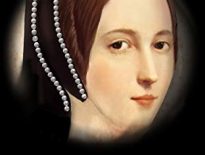On this day in Tudor history, 20th November 1591, Sir Christopher Hatton, Elizabeth I’s Lord Chancellor and favourite, died aged fifty-one. He was such a favourite of Queen Elizabeth I that he had a dazzling career and was constantly at her side.
Find out more about Sir Christopher Hatton, his career and accomplishments, his patronage of learned men and explorers, and his special relationship with Elizabeth I, in today's talk.
Also on this day in history:
- 1515 – Birth of Mary of Guise (Marie de Guise), Queen of Scots, consort of James V, regent of Scotland and mother of Mary, Queen of Scots, at the castle of Bar-le-Duc in Lorraine. She was the eldest daughter of Claude of Lorraine, Duke of Guise, and Antoinette de Bourbon, daughter of Francis, Count of Vendome, and Marie de Luxembourg. Mary was Queen Consort of Scotland from 1538-1542, and regent from 1554 until her death in 1560.
- 1518 – Death of Sir Marmaduke Constable, soldier and administrator. He served in France with Edward IV and Henry VII, and although he fought on the side of Richard III at the Battle of Bosworth, he managed to gain Henry's trust. He commanded the left wing of the forces under Thomas Howard, Earl of Surrey, at the 1513 Battle of Flodden, and this service led to him receiving a letter of thanks from King Henry VIII.
- 1556 – Death of Sir John Godsalve, member of Parliament, landowner and administrator, at Norwich. He was buried in St Stephen's Church, Norwich, in the Lady Chapel. Godsalve's offices included Constable of Norwich Castle, Keeper of the Gaol there, commissioner for chantries in Norfolk and Suffolk, Justice of the Peace for Norfolk and Comptroller of the Tower of London Mint.
- 1558 – Death of Maurice Griffin, Bishop of Rochester, probably at the Bishop's Palace in Southwark. He was buried at the church of St Magnus the Martyr, London Bridge. Griffin was Welsh and he left provision in his will for the setting up of Friars School in Bangor, with the support of William Glyn, Bishop of Bangor, and Jeffrey Glyn.
- 1600 – Burial of Robert Wilson, actor and playwright, at St Giles Cripplegate in London. Wilson acted in the companies Leicester's Men and the Queen's Men, and is known for his plays which include “The Three Ladies of London” (1581), “The Three Lords and Three Ladies of London” (1590), “The Cobbler's Prophecy” (1594) and “The Pedlar's Prophecy” (1595). He was also one of Philip Henslowe’s writers, writing plays for the Rose Theatre.
- 1612 – Death of Sir John Harington, courtier, author and inventor of the flush toilet. He was buried at the family estate of Kelston, near Bath.
Transcript:
On this day in Tudor history, 20th November 1591, Sir Christopher Hatton, Elizabeth I’s Lord Chancellor and favourite, died aged fifty-one.
Sir Christopher Hatton, the man Elizabeth I nicknamed her “mouton” (sheep) and her “lids”, was born in around 1540 in the reign of King Henry VIII. He was the son of William Hatton of Holdenby, Northamptonshire, and his wife, Alice Saunders, and was educated at St Mary Hall, Oxford, and then enrolled in the Inner Temple, one of the four Inns of the Court in London, in 1560.
It is not known exactly when Queen Elizabeth I noticed him, but it may have been in the Inner Temple festivities performed to the queen at New Year 1562, in which Hatton may well have participated, along with Robert Dudley. He became one of the queen’s gentleman pensioners in 1564 and was also chosen to welcome the Scottish ambassador and to escort him into the queen’s presence.
As one of Elizabeth I's favourites, he had an amazing career. Offices included Captain of the Queen’s bodyguard (1572), Vice-Chamberlain of the Royal Household and member of the Privy Council (1578), Queen’s Spokesman in the House of Commons (1578), Lord Chancellor (1587), Chancellor of the University of Oxford (1588) and High Steward, Salisbury (1590).
Between 1564 and 1587 he was such a favourite that he saw the Queen most days, and the longest he was ever away from court was one week. This led to Mary, Queen of Scots claiming that he was Elizabeth's secret lover. He was a member of the commission that found Mary guilty of treason in 1586, and was one of the councillors who urged William Davison, Elizabeth I's private secretary, to send Mary, Queen of Scots’ death warrant to Fotheringhay.
Elizabeth’s favour is apparent not only in the offices she gave him and the duties she entrusted him with, but also in the gifts she lavished on him, such as in 1572 when she gave him 400 oz of silver plate, which Wallace T. MacCaffrey points out was twice the amount awarded to ranking dignitaries and eight times the usual gift of 50 oz. He was said to be a good dancer, he took part in jousting, and not only enjoyed the tradition of courtly love, but was what MacCaffrey calls “a consummate player”. MacCaffrey goes on to say that “His role was that of the perpetual suitor, who forever worships an earthly goddess with unwavering devotion—a devotion that cannot be fulfilled but never wanes”, and that when he wrote to Elizabeth from Spa in 1573, he said “This the twelfth day since I saw the brightness of the sun that giveth light unto my sense and soul, I wax an amazed creature”. He had a way with words! He would also use a special symbol in his letters to her – three parallel triangles.
He seems to have genuinely cared for Queen Elizabeth. MacCaffrey notes that he was unmarried and had no family to benefit from his favour, that his loyalty to her was undivided, and that they had a very special and stable relationship. He was also a reliable councillor, his attendance record being as high as Sir Francis Walsingham and William Cicil, and was used by the council as a mediator with the queen, due to his good relationship with her. The only time there seems to have been trouble between the queen and Hatton, was when he sided with the Earl of Leicester in opposing the queen’s plans to marry the Duke of Anjou. Hatton ended up being banished from her presence for a week.
As well as being a charming intelligent man and a loyal servant of the queen, Sir Christopher Hatton also served as a patron to men of learning, earning his many dedications in works. He also invested in overseas expeditions, supporting Sir Francis Drake’s circumnavigation and Martin Frobisher’s North-West passage voyages.
Sir Christopher Hatton died on this day in 1591 at Ely Place in London. He had been ill for some time and Elizabeth I had visited him on the 11th November. He was given a state funeral on 16th December 1591 at the old St Paul’s Cathedral, and a monument was erected at the high altar by his nephew, William. Unfortunately, old St Paul’s Cathedral was destroyed in the Great Fire of London in 1666.



Leave a Reply